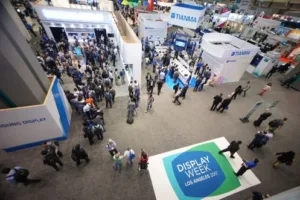Think about all the places you use a display. Cars, phones, TVs, and mobile devices are on the consumer side, but they are everywhere in the industrial, commercial, and military world too. China has perhaps 80% of the worldwide display capacity. Suppose China stopped or limited shipments of displays to the U.S. as part of the current trade war. The US has no domestic supply and friendly countries like Taiwan, Korea and Japan could not easily meet demand. What would the US government do? What does your company need to do to navigate these troubled waters?
Such strategic thinking and planning is now a necessary reality. Fortunately, a major display-focused trade show (Display Week) will take place next week in San Jose, California. I will be there to learn more about strategic and tactical thinking in the display supply chain and to see and hear about some of the key developments in display technology. I invite you to attend as well and offer this discount code 4wXFE!x for a free exhibit pass at the event.
Why is it important to attend in person? Because the impact of tariffs will be a key topic at the event. If the supply of materials, components or displays is important for your business, this is where you can have face-to-face conversations on what key players think and are doing to mitigate risk. While display-based products like smart phone, laptops and TVs have now been exempted from the 145% tariff on Chinese imports to the U.S., new tariffs on the semiconductors in these products are now expected. But China can still retaliate by limiting supply of panels, components or materials.
Having covered display technology for 30 years, a lot has changed, obviously. But the display industry remains incredibly vibrant with a host of challenges and opportunities. Display Week offers a glimpse of the future of the display industry via a robust exhibit floor with a near record number of exhibitors this year, along with keynotes, a business conference, a technical symposium, short courses, and focused seminars on display technology, AI and more.

The Business Conference is great for trend analysis and strategic concerns. The symposium sessions offer deep technical papers on developing aspects of display manufacture and emerging technologies. There are short courses and seminars that are designed as both introductory sessions and deeper dives into display technology. There is even a Displays 101 course with a guided exhibition tour for those new to the segment. AI is also a hot topic and one that will impact the display industry. There is a session on this aspect as well.


The exhibition floor is always a source of insight for me. This is the major U.S. show where the display supply chain shows off its latest display technology and products. All the major suppliers will be there plus supporting equipment, materials and component suppliers. The i-zone is a special place where small companies can showcase their latest technology – a must visit area.
What you see at Display Week can show up as products at CES next year and provide clues into the competitive struggles among a range of new and existing display technologies. It is also a place where new display products and technology shown at Touch Taiwan, will appear again at Display Week, thus offering the first U.S.-based opportunity to see and hear about these innovations.
Technology Challenges
LCDs has been king for a long time, but can OLED make a meaningful impact in its dominance? OLED is where panel makers are making investments in equipment and fab capacity in a bid to expand into tablets and laptops. Some are also investing in new OLED fabrication techniques like ink jet printing and alternatives to the fine metal mask method to lower the cost of production. Will these bets pay off?

But the LCD camp has been active too. miniLED backlights have been a hit in the TV sector and are now expanding into automotive and other verticals. Such backlights use white LEDs or blue LEDs coupled to quantum dot layers. Now, companies are introducing packaged red, green, and blue microLED emitters in the backlight to expand the color performance and luminance level of the display. Can other technologies compete with this?
Electroluminescent quantum dots – i.e. ones activated with voltage and current as opposed to light (photoluminescent), are in the early stages of commercialization too. Will they find a niche to support production or fade to withering competition.
And of course, there are microLEDs, which many see as the long-term ultimate display solution. But can this technology scale its manufacturing base to compete on a yield and cost basis with more mainstream applications? This will be a key topic of interest at Display Week.

Vertical Market Opportunities
There are also hot vertical market applications like AR/VR and automotive. So much money has been poured into AR/VR but key players are still losing money here. Will they continue to play the long game? What innovations will be revealed at Display Week that might help this segment?
Automotive is a clear bright spot with auto makers and tire one suppliers eager to expand the use of display in automobiles as well as commercial and industrial vehicles. LCDs and OLEDs lead here but there is a lot of activity in Head-up Displays and microLED solutions as well. I anticipate a lot of display demonstrations on the exhibition floor in this area.

I will be at Display Week and will have some video news reports on what I was able to take in. But there is so much more that I won’t be able to see, which is why I encourage you to be there in person.

Chris Chinnock holds a BSEE from the University of Colorado and has previously worked for companies such as General Electric, Honeywell, MIT Lincoln Labs and Barnes Engineering. In 1998 he founded Insight Media, which published newsletters (including Display Daily) and market reports plus custom consulting on the emerging parts of the display industry. Insight Media also produced many display events such Projection Summit, Display Summit, QLED and Advanced Display Summit, Streaming Media for Field of Light Displays (SMFoLD), and more. Chinnock also helped found and lead two display-focused industry organizations: the 3D @ Home Consortium and the 8K Association. He currently provides custom writing and marketing services for clients with advanced display-based technology.

